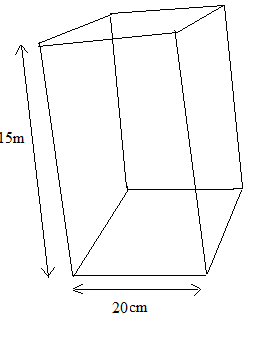
A vertical column, 15m metre high, has a square base on the side of 20cm. Find the cost in ($) of painting its vertical surfaces at the rate of 2.25 per square metre?
Answer
585.6k+ views
Hint- In this question, first we will make the diagram. Since the base is a square, the 3d figure that will form on the base will be the four walls. After this we calculate the area of the four walls and then calculate the cost of painting at the given rate.
Complete step-by-step answer:
The diagram for the question is given below:

The base of this cuboid is a square having each side length =20cm.
Four walls are made of this square base of length 15m. So, the resultant figure formed will be a cuboid without a top face.
We have to do painting on the four walls. Therefore, we have to calculate the area of the four walls.
Each of the four walls have length = 15m and breadth = 0.20m, forming a rectangle.
We know that the area of a rectangle is given by:
Area= length $ \times $ breadth.
$\therefore $ The area of each face/wall = length $ \times $ breadth = (15$ \times $0.20)${m^2}$ =3${m^2}$.
And the area of four walls = 4$ \times $area of each wall = 4$ \times $3${m^2}$=12${m^2}$.
Now, we have to calculate the cost of painting the four walls given the rate of painting =$ \$ 2.25/{m^2}$.
Cost of painting the four walls = rate of painting $ \times $area of four walls.
= $ \$ 2.25/{m^2} \times 12{m^2}= \$27$.
Therefore, the cost of painting the vertical surfaces = $ \$27$.
Note- In this type of question, first you should have to recognize which type of geometric figure is going to be formed. Once, you make the diagram. Then use the formula for finding the area of surfaces. In this case we have to find the area of four walls, so we will calculate the area of each vertical surface and then add them.
Complete step-by-step answer:
The diagram for the question is given below:

The base of this cuboid is a square having each side length =20cm.
Four walls are made of this square base of length 15m. So, the resultant figure formed will be a cuboid without a top face.
We have to do painting on the four walls. Therefore, we have to calculate the area of the four walls.
Each of the four walls have length = 15m and breadth = 0.20m, forming a rectangle.
We know that the area of a rectangle is given by:
Area= length $ \times $ breadth.
$\therefore $ The area of each face/wall = length $ \times $ breadth = (15$ \times $0.20)${m^2}$ =3${m^2}$.
And the area of four walls = 4$ \times $area of each wall = 4$ \times $3${m^2}$=12${m^2}$.
Now, we have to calculate the cost of painting the four walls given the rate of painting =$ \$ 2.25/{m^2}$.
Cost of painting the four walls = rate of painting $ \times $area of four walls.
= $ \$ 2.25/{m^2} \times 12{m^2}= \$27$.
Therefore, the cost of painting the vertical surfaces = $ \$27$.
Note- In this type of question, first you should have to recognize which type of geometric figure is going to be formed. Once, you make the diagram. Then use the formula for finding the area of surfaces. In this case we have to find the area of four walls, so we will calculate the area of each vertical surface and then add them.
Recently Updated Pages
Master Class 9 Social Science: Engaging Questions & Answers for Success

Master Class 9 Science: Engaging Questions & Answers for Success

Master Class 9 English: Engaging Questions & Answers for Success

Master Class 9 Maths: Engaging Questions & Answers for Success

Master Class 9 General Knowledge: Engaging Questions & Answers for Success

Class 9 Question and Answer - Your Ultimate Solutions Guide

Trending doubts
Which places in India experience sunrise first and class 9 social science CBSE

Fill the blanks with the suitable prepositions 1 The class 9 english CBSE

Write the 6 fundamental rights of India and explain in detail

Difference Between Plant Cell and Animal Cell

What is pollution? How many types of pollution? Define it

What is the Full Form of ISI and RAW





